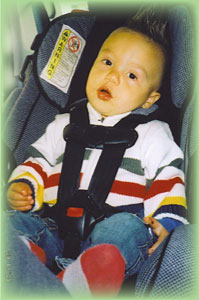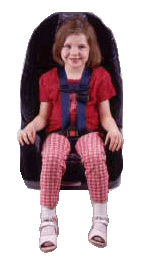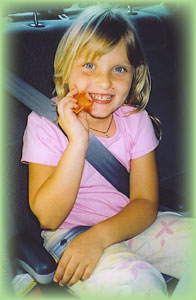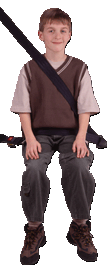Alaska Safety Belt and
Child Passenger Safety Laws |
| |
|
[ INFANTS ]
[ TODDLERS ]
[ BOOSTER ]
[ OLDER CHILD ]
[ TIPS ]
[ RECALLS ]
|
| |
| |
When choosing a safety seat for your child, keep in mind the following important points:
- The seat must meet federal standards.
- The seat must fit properly in your car. Read your vehicle owner's manual for information about using a child restraint in your vehicle.
- The seat must be appropriate for the child's weight and height. To determine whether it is, read the safety-seat manufacturer's instructions. Place the safety belt exactly where the instructions recommend it be placed.
- You can't be sure about the history of a used seat. Best practice is to purchase a new seat.
|
|
| INFANTS |
[ Back to Top ] |
| (Five to 20/22 pounds) |
| |
 |
| |
| Use safety seats designed for children under 20/22 pounds. |
| |
- Infants should ride rear-facing to at least 20 pounds and at least one year of age.
- Infants should ride reclined, up to a 45-degree angle.
- Thread the harness straps through the lowest pair of slots in the back of the seat. This will help keep the baby restrained in the seat, providing additional protection in a crash.
- Buckle the harness system between the infant's legs.
- Tighten the harness so that the child is snugly secured in the seat.
- Secure the safety belt to the safety seat. The safety seat should not move more than 1 inch toward the front of the vehicle or side-to-side.
|
| Air bag warning: |
| |
- Never place a child in a rear-facing safety seat in front of an air bag.
- All children ages 12 and under are safest riding secured in the back seat.
|
| |
|
| TODDLERS |
[ Back to Top ] |
| (20/22 to 40 pounds) |
| |
 |
| |
- Children weighing between 20 and 40 pounds and over one year of age may ride forward-facing in a convertible safety seat or harness system. If a child does not meet both the minimum weight and age, then he/she should continue to ride rear-facing in an appropriate safety seat.
- Thread the harness straps through the top pair of slots in the back of the safety seat.
- Buckle the harness system between the child's legs.
- Tighten the harness so that the child is snugly secured in the seat.
- Secure the safety belt to the safety seat. The safety seat should not move more than 1 inch toward the front of the vehicle or side-to-side.
|
| Safety advocates recommend using a safety seat equipped with a five-point harness system. |
| |
| Air bag warning: |
| |
- Never place a child in a rear-facing safety seat in front of an air bag.
- All children ages 12 and under are safest riding secured in the back seat.
|
| |
|
| BOOSTER |
[ Back to Top ] |
| (40 to 80 pounds) |
| |
 |
| |
Children weighing between 40 and up to 80 pounds should be restrained by a belt-positioning booster seat.
Belt-positioning booster seats, which are used in conjunction with the vehicle's lap-and-shoulder safety-belt system, provide good upper-body protection for children weighing more than 40 pounds.
A booster seat keeps the vehicle safety belt positioned correctly over the strongest bones -- the shoulders and hips. Without a booster seat, the vehicle safety belt system will likely not adequately fit a child within this weight range.
|
| Air bag warning: |
| |
- Never place a child in a rear-facing safety seat in front of an air bag.
- All children ages 12 and under are safest riding secured in the back seat.
- http://www.johnwalsh.tv
|
| |
|
| OLDER CHILDREN |
[ Back to Top ] |
| (Over 80 pounds) |
| |
 |
| |
When children have outgrown safety seats (around 80 pounds and about 4'9" tall), they graduate to safety belts.
- Lap belt should fit low across hips, NEVER across the face, neck or stomach.
- Shoulder belt should fit snug across shoulder, not neck.
- Generally, seat belts do not fit a child correctly until at least 60 pounds.
- Children should ride in a car seat or booster seat until a seat belt fits the child correctly.
|
| Air bag warning: |
| |
- Never place a child in a rear-facing safety seat in front of an air bag.
- All children ages 12 and under are safest riding secured in the back seat.
|
| |
|
| TIPS FOR TRAVELING WITH YOUNG CHILDREN |
[ Back to Top ] |
| |
- Never misuse safety seats. Follow the safety-seat manufacturer's directions and the vehicle instructions for buckling the seat into your car or truck.
- Begin using a safety seat immediately. Protect your newborn in a safety seat on the way home from the hospital and on every ride.
- Small children (not infants) can be included in the process of selecting a safety seat. Children are happier and more inclined to use a safety seat if they feel comfortable in the seat.
- Remind the child that the vehicle will not move until everyone is buckled up.
- Children are imitators. Set a positive example for your child by buckling up yourself on every trip.
- Don't keep books, bottles or other sharp, hard objects in your car or truck. In a collision such objects can become airborne, possibly striking and injuring you or your child. Provide a special soft toy for children to play with when riding in a motor vehicle.
- Don't let children eat while riding in a car or truck. A sudden stop could cause a child to choke.
- Lock your doors. Teach children not to play with door handles or locks.
|
| Air bag warning: |
| |
- Never place a child in a rear-facing safety seat in front of an air bag.
- All children ages 12 and under are safest riding secured in the back seat.
|
|
Please read your vehicle instructions to make sure that your safety belt will work with your safety seat.
In order for a safety belt to work it must remain tight when securing a safety seat.
|
| |
|
| SAFETY RECALLS |
[ Back to Top ] |
| |
 |
| |
| |